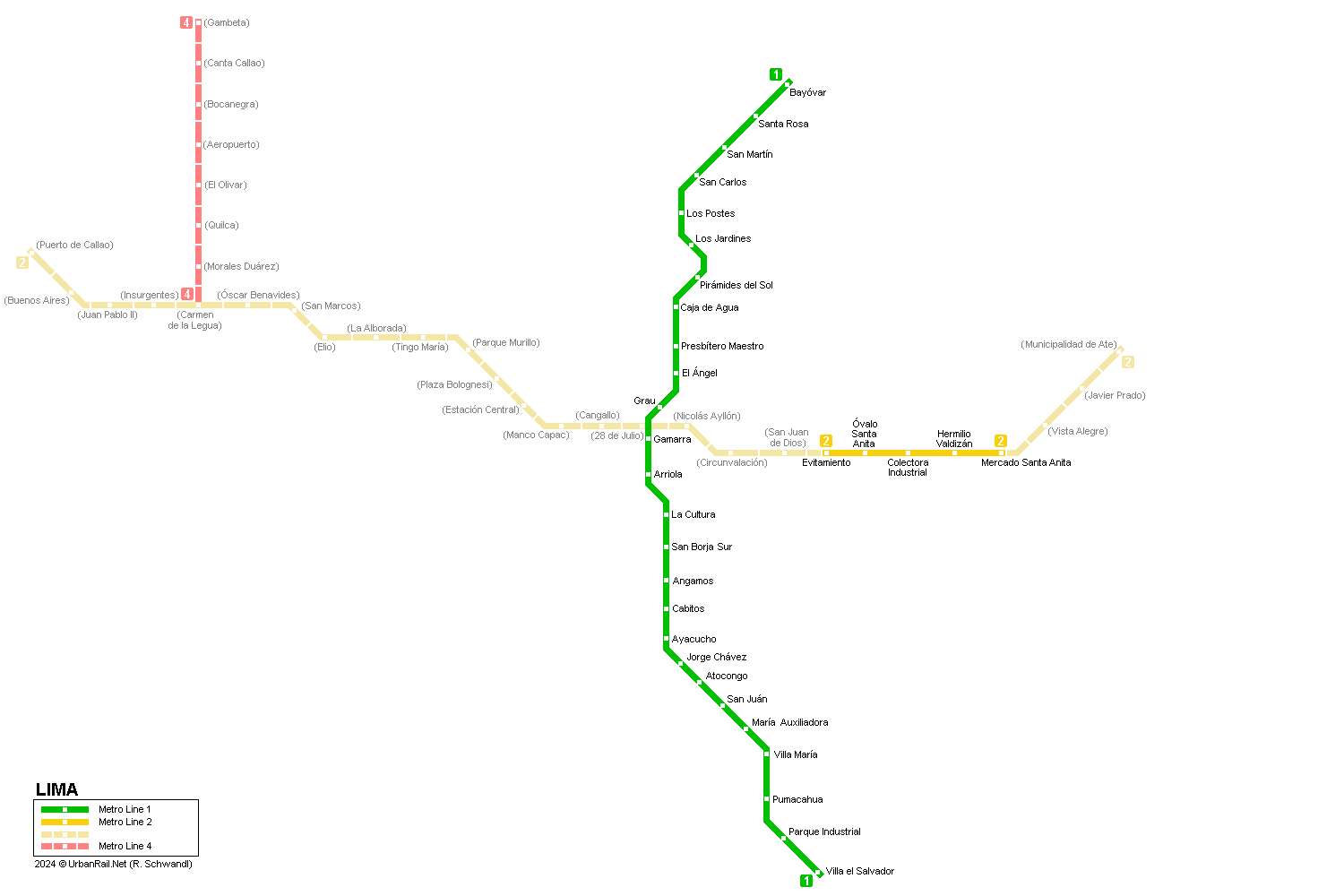
|
[ UrbanRail.Net ] [ Europe ] [ Americas ] [ Asia ] [ Africa ] [ Oceania ] [ News ] [ Books ] [ Links ] |
|
LIMA
|
| Peru |

|
METRO
|
|
Lima, the capital of Peru, has some 8 million inhabitants. In 1986, the Autoridad Autónoma del Proyecto Especial Sistema Eléctrico de Transporte Masivo de Lima y Callao was founded to develop the 'Tren Eléctrico'. Construction of the first section of Line 1 began, but towards the end of the 1990's construction came to a halt. 9.8 km had been built in the south of the city, from Villa El Salvador to Atocongo in the district of San Juan de Miraflores. In 1995, the first trial runs were untertaken on this stretch and repeatedly commercial service was announced but always postponed. Eventually construction towards the city centre (12.4 km) progressed and regular service finally started in 2012. |
|
Línea
1
|
|
34.4 km, 26 stations Phase
1 - 22
km, 16 stations, mostly elevated, partly at grade - 1435 mm gauge, overhead power supply, 1500 V dc - Rolling
stock: Line 1 Timeline: -
Oct. 2002: free trial service Villa
El Salvador - Atocongo
- 11
July 2011: Test operation between Grau and Villa El Salvador - 25 July 2014: Grau - Bayóvar (now with trains every 6-10 minutes from 06:00-23:00 on the completed L1) |
| Photos |
|
Photos 2014 © Jose L. Valdivieso |
|
Línea
2
|
|
East-west line from Callao to Vitarte along Guardia Chalaca, Venezuela, Arica, Grau and Nicolás Ayllón, fully underground, construction started in May 2015 21 Dec 2023: Evitamiento – Mercado Santa Anita (5 km) |
|
Projects |
|
A network with 5 lines is envisaged (See here): Line 3 from Callao to La Molina Línea tangential along Javier Prado, La Marina and Faucett. Line 4 (south - northeast) from Chorrillos to San Juan de Lurigancho along Paseo de la República, Abancay, 9 de Octubre and Próceres. Line 5 would run south along the coastline. |
| Line 2 Presentation Video: |
|
Photos
|
|
Links
|
|
Línea Uno (Metro Line 1 - Official Website) Metro Lima 2 (Metro Line 2 - Official Website) Metropolitano (City Transport Authority) Metro de Lima y Callao at Wikipedia.es
|
| Report |
|
In February 2018, Craig Moore reports from Lima: The Metro de Lima is a single-line system, running 33.4km of revenue track from the poorer northern suburbs, via the eastern fringes of the city centre, and down to the southwest of the city near the coast. The line has 26 stations and runs on elevated viaduct for its entire length. Given the long gestation period of this line (12 years from initial opening to start of full revenue services), it is unsurprising that there are different styles amongst the stations, with the original older stations in the south having shallower, angled roofing, as opposed to the gentle corrugated half-arches in the centre and to the north. All stations, though, have uniformity in terms of their uncomplicated, basic feel, unburdened by design style or any niceties. As the line runs above a series of main roads, the stations are prominent with access via pedestrian crossings to the central area under the rail viaduct, or more rarely, from external stairs and overhead walkway. The stations are of an appropriate scale and have several sets of angular external stairs which give the stations a unique but awkward look – no smooth, streamlined exteriors here in Lima. The totem is a beacon of colour in the station area with its flash of bright green, topped by the smart triangular ’Linea 1’ logo. The station names are in bold white capital letters which run the length of the entrance under the tracks. Here is found the ticket office, a couple of ticket recharge machines, basic and incomprehensible geographic map, and a set of standard barriers upon which the Tarjeta is tapped. Flat fares operate (5 Soles) (€1.24) but you also have to purchase a Tarjeta for 15 Soles, so for an occasional visitor who wants the odd ride, this is quite expensive. The entrance hall is bereft of any niceties and is a large shady space below the rail lines, which offers stairs, occasionally operating lift or escalator to the platform levels. At stations with a slightly higher viaduct level and with heavier footfall, there is a mezzanine floor with small shops and food outlets (e.g. Miguel Grau). The platforms continue the basic feel of the entrance. All are side platforms which are quite shallow. There are occasional seats, posters with start-finish times and headways (0600-2230) 10min base headway/5min peak headways). There is a vertical strip map of the line with the current station reversed out in orange, and an orange band attached to the ceiling with station name. There is no RTI or station announcements, and this would be useful as my experience was that trains often ran late and there was unequal spacing of services. The line is endlessly busy and all trains are packed full along the entire route, although Miguel Grau to San Juan is the busiest section. 10min frequencies are really not enough to meet demand and this is certainly not a pleasantly relaxed experience. Most services operate with Alstom Metropolis 9000 stock in 5-car sets. These are through trains and have white and green exteriors and the interiors have side seating and a smart green strip map with illuminated progression. Occasional services are provided by the original metallic and red Ansaldo Breda trains. These have six individual cars and appear to be more specious inside. In train audio information is in Spanish only. Services run at 75/80kph and the ride is pretty jerky with some heavy breaking as the line twists its way through the city, but the line does afford some great views of the city and provides are more realistic observation of Lima and its poorer neighbourhoods than a visit to Miraflores or the historic core would (both of these main areas are quite a distance from the Metro which runs a couple of kilometres to the east. Despite this, and the minimal security presence on platforms and trains, the feel of the line is quite safe as long as normal precautions are taken. And so, this is a peculiar Metro. Given the patronage levels, this is a line of great value to many in the Peruvian capital, but for the occasional user you have to work hard to use it - the route is quite inconvenient for many of the main parts of Lima, it is relatively expensive, cramped and has a basic feel despite its young age. Certainly when in the midst of it all you don’t get the feel that you are riding the most isolated Metro on the planet - the Metro de Lima has the longest distance to the next nearest functioning Metro (2042km to Medellin) - Novosibirsk (1373km to Almaty) is the second most isolated Metro by my reckoning!
|
| Photos |
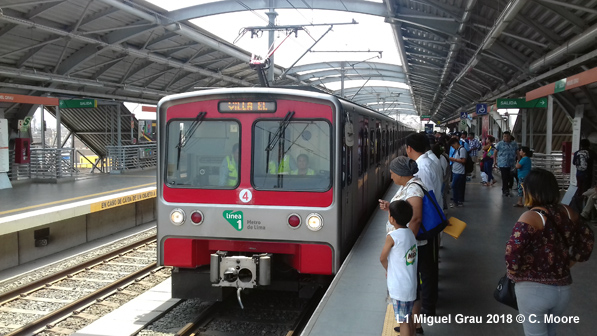
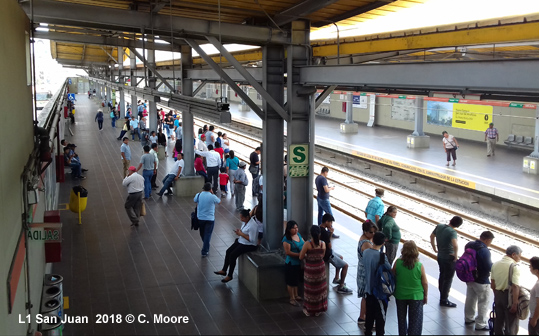
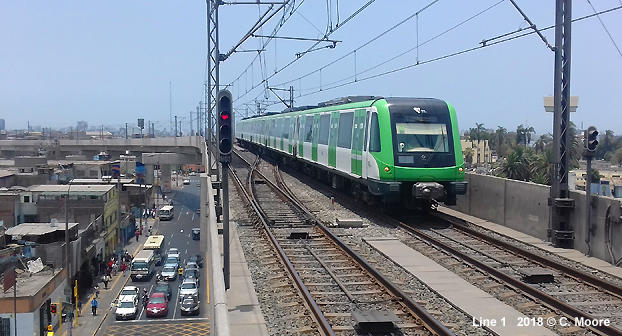
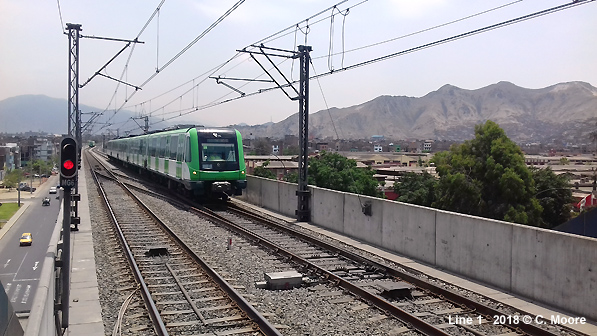
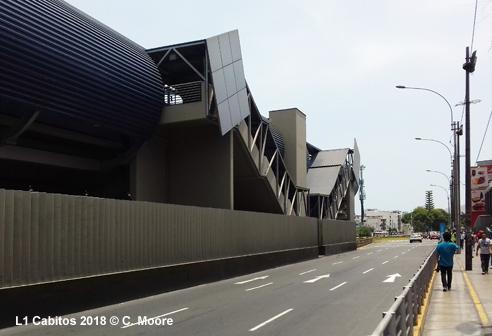

|
2007 © Robert Schwandl (UrbanRail.Net)